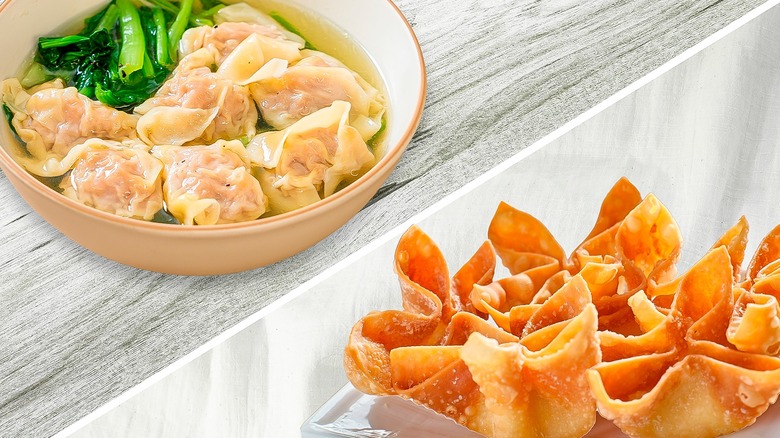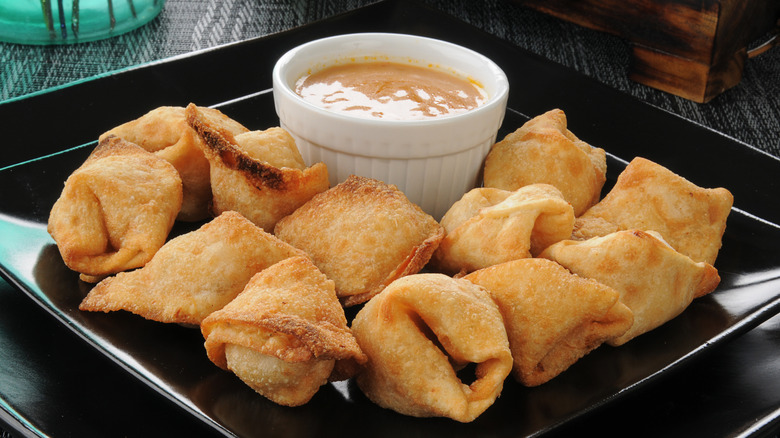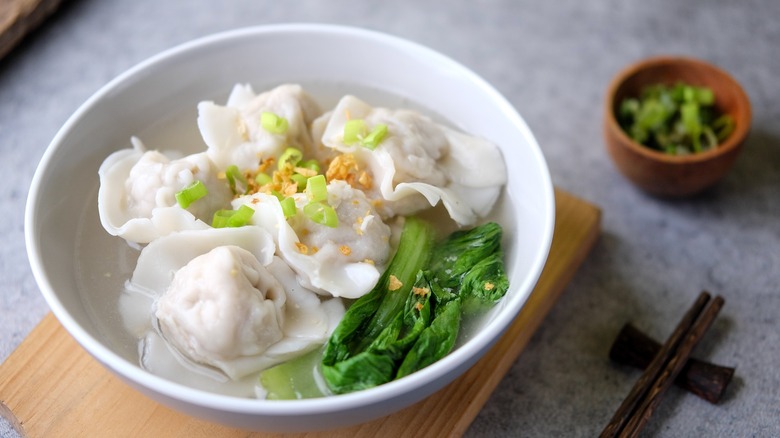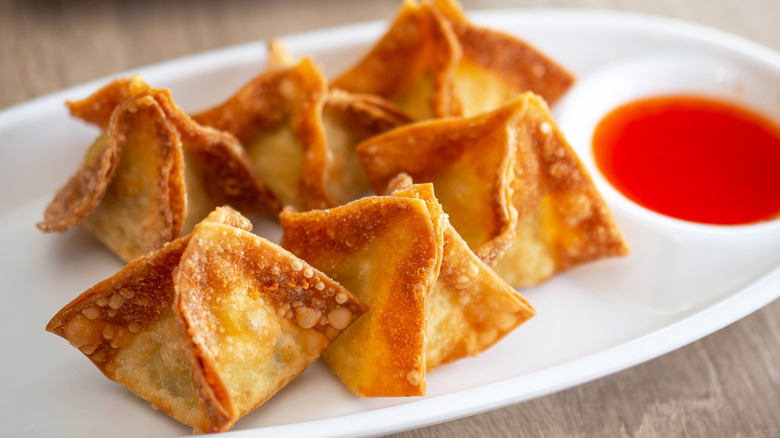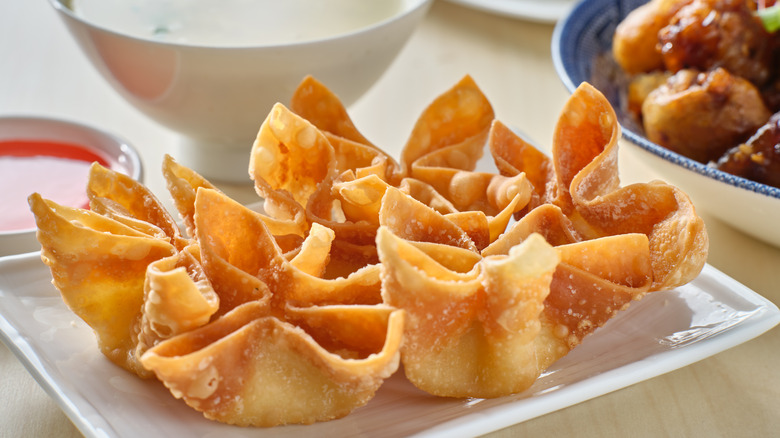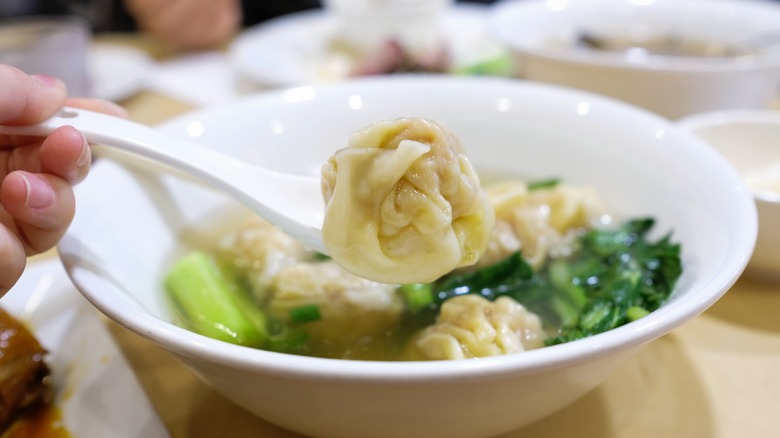The Difference Between Crab Rangoon And Wontons
In the vast array of Asian cuisine, some dishes can be confused due to regional or national takes on the foods. Two such dumplings that are often conflated include crab rangoon and wontons. These delightful morsels, though sharing the same thin, doughy wrapper, possess distinct flavors, origins, and textures that make them both unique and irresistible.
Crab rangoon, a fusion creation born in mid-20th century America, features a creamy filling of cream cheese, crab meat (or imitation crab), scallions, and seasonings. Encased in a crispy, deep-fried wonton wrapper, it offers a delightful contrast of textures and flavors. Wontons, on the other hand, are a centuries-old Chinese classic, known for their versatility and comforting qualities. They typically embrace a savory filling, often a combination of ground pork, shrimp, and aromatic seasonings, encased in a delicate, silky dough.
Whether you're savoring the sweet and tangy allure of crab rangoon or diving into the savory, meaty world of wontons, both dumplings invite you to embark on a flavorful journey through the rich tapestry of Asian culinary traditions.
What is crab rangoon?
Contrary to popular belief, crab rangoon is not a traditional Chinese dish. Its roots can be traced back to tiki culture in mid-20th century America. Created by Victor J. "Trader Vic" Bergeron, the founder of the Trader Vic's restaurant chain, crab rangoon was conceived as part of his Polynesian-inspired menu. This dish reflects a fusion of American tastes and an imaginative twist on Chinese flavors.
Crab rangoon features a filling made from a mixture of cream cheese, crab meat (or imitation crab), scallions, and various seasonings. The filling is then enveloped in a thin, crispy wonton wrapper, sealed into the shape of a pouch, and deep-fried to golden perfection. The result is a crunchy exterior that gives way to a creamy, savory interior. Because crab rangoon is very similar to wontons made with a specific filling combination, it's easy to see why some people might confuse the two dishes.
What are wontons?
Wontons, on the other hand, are an authentic Chinese creation that dates back centuries. These delightful dumplings are believed to have originated in the Jiangxi province of China during the Tang Dynasty (618–907 AD). Wontons have since become a staple of Chinese cuisine, loved for their versatility and comforting qualities.
Wontons are traditionally filled with a mixture of ground pork, shrimp, or a combination of both, along with seasonings such as ginger, garlic, scallions, and soy sauce. The filling is carefully wrapped in a delicate, thin dough made from wheat flour, water, and sometimes egg. Wontons can take various shapes, including the classic triangle, a simple fold-over, or a more intricate pleated form.
While these dumplings are typically served alongside broth, it isn't uncommon to find them as a fried dish on menus. But to better understand exactly what sets these two types of dumplings apart from one another in addition to their fillings and origins, let's take a closer look.
Crab rangoon has a specific filling
The distinction between the filling inside crab rangoon and wontons lies at the heart of their culinary uniqueness. Crab rangoon features a rich and creamy interior. Its filling combines cream cheese, crab meat (or imitation crab), scallions, and a medley of seasonings. This mixture creates a luscious, slightly sweet, and tangy flavor profile, resulting in a delightful contrast to its crispy, deep-fried wonton wrapper.
In contrast, the filling of wontons is a savory symphony of flavors. Traditional wonton fillings typically include a blend of ground pork and shrimp, infused with aromatic ingredients like ginger, garlic, scallions, and soy sauce. The result is a rich umami taste that's both meaty and deeply satisfying. The wonton's thin, tender dough wrapper perfectly complements this savory filling, creating a harmonious balance that's enhanced when served in a flavorful broth. So, while crab rangoon tempts with its creamy sweetness, wontons entice with their savory richness, showcasing the delightful diversity within the world of dumplings.
Wontons have a crisp wrapper
The distinction between the wrappers of crab rangoon and wontons lies in their texture and preparation method. Crab rangoon employs a thin wonton wrapper that is typically circular, similar to those used in other Asian dumplings. These wrappers are designed to become wonderfully crispy when deep-fried, providing a delightful contrast to the creamy filling inside. They achieve a delicate, golden-brown crunch, adding a layer of textural excitement to each bite.
On the other hand, wontons feature a more delicate and thin square wrapper. These wrappers are skillfully crafted to be tender and silky when cooked, embracing the savory filling within. They come in various shapes, including the classic triangle, simple fold-over, or intricate pleated designs, and are commonly boiled, though they can be fried. The thin wonton dough becomes a silky canvas that complements the savory and meaty filling, offering a velvety contrast to the flavorful interior. So, while both crab rangoon and wontons share the use of wonton wrappers, the way these wrappers are prepared and the textural experiences they deliver set them apart, making each dumpling a unique culinary delight.
Crab rangoon has a crisp, creamy texture
The distinction in taste and texture between crab rangoon and wontons lies at the core of their culinary charm. Crab rangoon, with its fusion flair, tantalizes with a creamy, slightly sweet, and tangy flavor. The combination of ingredients creates a rich, velvety texture that perfectly complements the crispy, deep-fried wonton wrapper. The result is a delightful interplay of textures and flavors, where the creamy interior offers a lush contrast to the crunchy exterior.
Conversely, wontons showcase a savory and meaty flavor profile. The thin, tender dough wrapper adds a comforting and velvety texture to each bite. While crab rangoon teases the palate with its creamy sweetness and crispy crunch, wontons invite savory complexity through more subtle flavors, showcasing the remarkable diversity within this corner of Chinese cuisine.
So, the next time you explore the world of dumplings, savor the unique qualities of crab rangoon and wontons, celebrating the diverse tapestry of flavors found in these culinary gems.
